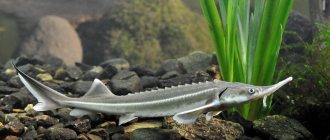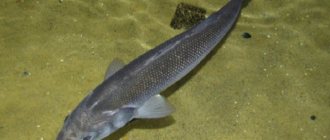Beluga is a fish of the sturgeon family, which today is an endangered species as a result of unauthorized catching and brutal extermination for the sake of caviar.
This is the largest fish found in fresh water. It is enormous in size (the largest known specimen reaches 6 m in length and weighs about two tons).
Beluga is a fish of the sturgeon family, which today is an endangered species
Specimens of this size are almost never found these days. Due to the fact that until recently this species was a commercial species, as well as due to the loss of natural spawning grounds, the population has noticeably decreased. So you won’t see an unusually large fish today.
Description
Beluga
Beluga is a unique fish that lives for a very long time, and its maximum age can reach hundreds of years. It can spawn more than once in its life, and after spawning it slides into the sea. The fertility of females depends on their size and sometimes reaches about 500,000 eggs.
In nature, beluga is an independent species, however, it can hybridize with sturgeon, sterlet, thorn and stellate sturgeon. Hybrid sturgeon species are best grown in special pond farms.
There are many legends and myths associated with this amazing fish. For example, ancient fishermen said that the beluga stone protects a person very well from storms during a sea voyage and attracts catch. This stone, according to fishermen, can be found in the kidneys of a beluga, and it looks like a chicken egg. In ancient times, its owner could exchange the stone for any expensive product. This legend is still believed, although there is no exact information about the reality of the stone.
Description of beluga
Beluga is the largest freshwater fish living in the waters of our country . It has lived on Earth for almost 200 million years and, like all other sturgeons, has learned to adapt to a wide variety of living conditions. These fish do not have a spine, and instead of a skeleton there is a flexible chord.
Appearance
Beluga is distinguished by its large size: its weight can be equal to one and a half tons, and its length can be more than four meters. Some eyewitnesses even saw belugas reaching a length of nine meters. If all this anecdotal evidence is true, then the beluga could be considered the largest freshwater fish in the world. She has a thick and massive body.
With its head and the shape of its muzzle, the beluga resembles a pig: its snout, somewhat like a snout, is short and blunt, and its huge, toothless mouth, which occupies almost the entire lower part of the head, surrounded by thick lips, has a sickle shape. Only beluga fry have teeth, and even those disappear after a short time. The antennae, hanging down from the upper lip and reaching the mouth, are slightly flattened downwards. The eyes of this fish are small and blind, so it navigates mainly with the help of a well-developed sense of smell.
This is interesting! The name beluga (Huso huso) is translated from Latin as “pig”. And, if you take a closer look, you can really notice that these two creatures are similar in some ways, both in appearance and in their omnivorousness.
Male and female belugas differ little in appearance and their bodies are both covered with equally large scales. The scales look like diamonds and do not overlap each other anywhere. This type of scale is called ganoid. The beluga's back is gray-brownish, its belly is lighter.
Behavior and lifestyle
Beluga is a migratory fish; it mainly leads a bottom-dwelling lifestyle. The very appearance of this amazing creature, reminiscent of the appearance of ancient armored fish, indicates that the beluga rarely appears on the surface: after all, with such a massive body, it is more convenient to swim in deep water than in the shallows.
It constantly changes habitats in the reservoir and often goes to the depths: there the current is faster, which allows the beluga to find food, and there are deep holes that this fish uses as resting places. In spring, when the upper layers of water begin to warm up, it can also be seen in shallow water. With the onset of autumn, the beluga again goes into the depths of the sea or river, where it changes its usual diet, eating mollusks and crustaceans.
Important! Beluga is a very large fish; it can only find enough food for itself in the seas. And the very presence of belugas in a reservoir is evidence of a healthy ecosystem.
Beluga travels vast distances in search of food and spawning grounds. Almost all beluga whales tolerate both salt and fresh water equally well, although some species can live exclusively in fresh water bodies.
How long does a beluga live?
Beluga is a real long-liver . Like all other sturgeon, it matures slowly: up to 10-15 years, but lives for a very long time. The age of this fish, if it lives in good conditions, can reach one hundred years, although now belugas live forty years.
Return to content
Origin
Sturgeon breeds include: beluga, stellate sturgeon, sturgeon, sterlet. In the fossil state, sturgeon fish have been known only since the Eocene (85.8-70.6 million years ago). From a zoogeographical point of view, very interesting are the representatives of the shovelnose subfamily, which are found on the one hand in Central Asia, on the other in North America, which makes it possible to see in modern species of this genus the remains of a formerly widespread fauna. Sturgeons are one of the most unique and attractive species of ancient fish. They have existed for more than 200 million years, and lived even when dinosaurs inhabited our planet. With their unusual appearance, in their clothing made of bone plates, they remind us of ancient times when special armor or a strong shell was needed in order to survive. They have survived to this day, almost unchanged. Alas, today all existing species of sturgeon are in danger or even threatened with extinction.
Population and species status
By the beginning of the 21st century, the beluga population had decreased significantly, and this species itself began to be considered endangered and was listed in the Red Book of Russia and the International Red Book.
In the natural environment, due to the small population of its species, beluga can interbreed with other related sturgeon fish . And in 1952, through the efforts of scientists, an artificial hybrid of beluga and sterlet was bred, which was called bester. It is bred, as a rule, in artificial reservoirs, since bester is not released into natural ones, where other sturgeon fish are found, in order to keep the natural populations of other species clean.
Return to content
View
Beluga is considered the largest of all freshwater fish. The body of an adult reaches a length of 4.2 m, and the weight is about 1.5 tons, with females being slightly larger than males. The beluga's thick, cylindrical body is covered with five rows of bone formations - scutes, and noticeably tapers towards the tail. The bone plates covering the head, sides and belly are poorly developed. More durable shields, 13 in number, are located on the back and perform a protective function.
Like all ray-finned fish, the fins of the beluga are distinguished by the presence of long and sharp, jagged rays: the dorsal contains at least 60 rays, the anal from 20 to 40. The elongated head ends in an upturned, pointed nose, which is slightly translucent as a result of the absence of bony scutes. The beluga's mouth is quite wide, but does not extend beyond the sides of the head; a fleshy upper lip hangs over it. The antennae, located on the sides of the lower jaw, are wider and also longer than those of most sturgeons and perform an olfactory function. The beluga's back is greenish or ash-gray in color, its belly is white or light gray, and its nose is characteristically yellow.
The largest beluga
The largest beluga caught in Russia in 1922 still holds the title. She weighed 1224 kg and was caught in the Caspian Sea. The giant fish was filled with caviar. The Tsar Fish is comparable in size to ocean monsters: sharks, killer whales, narwhals.
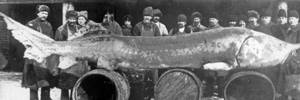
Several other cases of giant-sized beluga sturgeons have been caught. In Kazan there is even a stuffed giant fish, which weighed a ton during its life. The 4.17 m long carcass was donated to the city by Nicholas II himself, and today a stuffed animal made from it is exhibited in the museum. Anyone can admire the huge fish.
Another curious specimen during life had a length of almost 6 meters and a weight of up to a ton. His story is amazing. This beluga was caught by poachers, the most valuable caviar was gutted, and the carcass was thrown away.
Distinctive features
In addition to its size, this fish can be distinguished from other sturgeon representatives by its thick, cylindrical body and short, pointed nose. It is slightly translucent due to the fact that there are no bone scutes on it. Her mouth occupies the entire width of her head, with a thick lip hanging over it. The antennae on the lower part of the head differ from the similar organ of other fish belonging to the sturgeon group in their width and length: in other fish they are smaller. The bony scutes on the head, sides and peritoneum are underdeveloped. On the back the number of scutes reaches 13, on the sides - 40-45, and on the peritoneum does not exceed 12.
Habitats
Belugas are migratory fish, and spend most of their lives in the waters of the Black, Azov and Caspian Seas, and migrate to rivers only during the breeding season, and after spawning they go back to the sea. By nature, belugas are solitary. Adults and mature individuals live at great depths; juveniles prefer shallow water, not far from the mouth of the river.
In summer, after spawning, the fish rests at medium depths and then fattens before hibernation. Before the onset of cold weather, the body of the beluga is covered with a “fur coat” of a thick layer of mucus, and the fish falls into a state of suspended animation until spring.
Beluga behavior
The first thing mentioned in any description of beluga fish is its method of spawning. The main place of life of this fish is the sea, but it goes to large rivers to spawn, as was already mentioned earlier.
It is noteworthy that the beluga has so-called spring and winter forms (races). In particular, fish comes to the Volga in two waves: in the first half of autumn - winter, in the first half of spring - spring. However, this river is still dominated by the winter beluga, which spends the winter in river holes and then immediately begins spawning in April-May. In the Ural River, on the contrary, most belugas belong to the spring race; they spawn immediately after entering the river, and then swim back to the sea.
Like any sturgeon, beluga is a predatory fish. The young feed on all kinds of invertebrates and mollusks, catching them near the bottom in river mouths. After entering the open sea, the grown young animals quickly switch to feeding on fish. In the Caspian Sea, the basis of the beluga's diet is carp, roach, sprat, etc. In addition, the beluga does not hesitate to eat its own young and other representatives of the sturgeon family. The Black Sea beluga feeds mainly on anchovy and gobies.
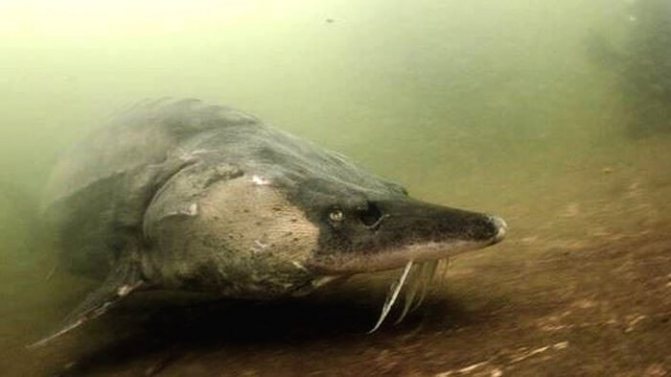
Beluga reaches sexual maturity late: males at 12-14 years, females at 16-18 years. Due to such a long maturation under conditions of intensive industrial fishing, this species was on the verge of extinction.
As already mentioned, beluga spawning occurs in the second half of spring, although a significant part of the fish go to rivers in the fall. Beluga spawns when the spring flood reaches its peak and the river water temperature is 6-7°C. Eggs rush on rapids in deep places (at least 4 meters, more often 10-12 m) with a rocky bottom. One female lays at least 200 thousand eggs, but usually they count in the millions (up to 8 million). The eggs are quite large, about 4 mm in diameter.
Having finished spawning, beluga fish in the Volga and other rivers quickly go to sea. Young larvae also do not stay in the river.
Lifestyle
Beluga fish
All sturgeon migrate long distances to spawn and in search of food. Some migrate between salt and fresh water, while others live only in fresh water their entire lives. They breed in fresh waters and have a long life cycle, taking years, sometimes decades, to reach maturity when they are first able to produce offspring. While annual successful spawning is almost unpredictable, depending on available habitat, suitable currents and temperature, specific spawning locations, frequency and migration are predictable. Natural crossing is possible between any species of sturgeon. In addition to entering rivers in the spring for spawning, sturgeon fish sometimes enter rivers in the fall for wintering. These fish stay mainly near the bottom.
According to the method of feeding, the beluga is a predator, feeding mainly on fish, but also on mollusks, worms, and insects. It begins to prey while still a juvenile in the river. In the sea it feeds mainly on fish (herring, sprat, gobies, etc.), but does not neglect shellfish. Even baby seals were found in the stomachs of the Caspian beluga.
Large fish need a lot of food, and the size of individual individuals directly depends on the diet: the better the fish eats, the larger the size it reaches. The main food of the beluga is various types of fish, and the beluga begins to prey at a very young age, as a fry.
Adults successfully hunt both on the seabed and in the water column. The favorite foods of beluga are gobies, herring, sprat, sprat, anchovies, roach, anchovy, as well as representatives of the numerous carp family. A certain part of the diet consists of crustaceans and mollusks, and even small animals, for example, baby Caspian seals or waterfowl.
Reproduction
Belugas are long-lived animals, some specimens live up to 100 years, so they reach reproductive age late. Males are ready to breed at the age of 13-18 years, females mature at 16-27 years. Spawning occurs at different times of the year and depending on this, beluga of the spring and autumn runs are distinguished.
Spring beluga enters rivers from late January until almost summer. The autumn beluga begins its migration at the end of summer and ends in December, so it is forced to winter at the bottom of the river in deep holes, and begins to reproduce only next spring. Each sexually mature individual does not reproduce every year, but at a certain interval, usually 2-4 years. The spawning grounds of beluga pass along deep rocky ridges, amidst fast currents.
The fertility of a female depends on her size, but in any case, the amount of eggs spawned is 1/5 of her own body. The average amount of caviar is from 500 thousand to a million. Dark gray eggs, 3 mm in diameter, look like peas. Thanks to its increased stickiness, caviar sticks perfectly to cold underwater rocks. At a water temperature of + 12-13 degrees, the incubation period is only 8 days.
Once born, the fry immediately switch to higher nutrition, bypassing the diet consisting of simple organisms. Without stopping, the juveniles go to the seas, where they live until the onset of puberty.
Range yesterday and today
The fish lives in the Caspian, Azov and Black Seas. However, it swims into rivers to spawn.
The largest distribution of beluga is in the Caspian Sea; it spawns most often in the Volga River, but can also swim into the Terek, Ural, and Kura rivers. In small numbers, the fish swim to spawn in small rivers flowing into the Caspian Sea, near Azerbaijan and Iran.
Until now, beluga whales often swam several hundred kilometers or more along rivers, but now, after the construction of numerous hydroelectric power stations, their capabilities are significantly limited.
The Black Sea was quite teeming with beluga sturgeon, especially its northwestern part. Now the population has thinned out significantly for the same reasons - the construction of a hydroelectric power station (before construction, fishing could be very successful even in Kyiv and Belarus). The fish is found off the coast of the Caucasus; it also lives in the southern part of Crimea. Spawning most often occurs in the large rivers Dnieper, Dniester, and Danube.
Number protection
Due to various reasons, this species of fish has significantly reduced its population and may disappear. Therefore, the beluga is listed in the Red Data Books of all countries in whose water bodies it is still found. The fish is prohibited from catching according to the relevant Fishery Rules. It is in the Red Book of the International Union for Conservation of Nature. Beluga fishing is only possible with a license. It indicates the number of fish that can be caught and their size.
Illegal fishing of beluga is punishable by a fine. It is different in different countries. In Russia, for each individual it is 12.5 thousand rubles. In addition, a number of fines are levied; for example, up to 5 thousand rubles. for illegal fishing, etc. In addition, there is criminal liability for illegal beluga fishing. Depending on the damage caused, this may include community service or imprisonment for up to 5 years.
Like other fish, belugas are bred artificially. True, much less common than other sturgeons. This “inattention” to fish is explained by its long-term growth - the first caviar from them can only be obtained after 17...18 years. And although the price of caviar exceeds 10 thousand dollars/kg, few entrepreneurs undertake to grow this fish.
Dilution is carried out in closed water supply devices. They represent several pools of round or rectangular shape. They can be portable (made of lightweight materials), stationary, for example, concrete, tiled. Their usual dimensions are: depth - 1.5 m, diameter - 2.5...3 m.
Human interaction
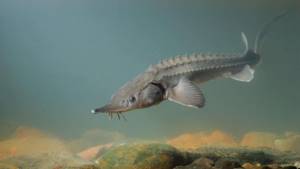
The experience of interaction between beluga and humans is extremely negative. In the 19th century, fish were actively caught with nets, since their meat and caviar are of great value and are very expensive.
Interesting fact : it is almost impossible to buy beluga caviar in a store, but if you manage to find at least one jar, you will need to pay about 15 thousand rubles for 100 grams.
During the second half of the 19th century, the number of beluga decreased significantly. To save the species from extinction, a ban on its catching in Russia was introduced in 2000. In 2021, the ban began to apply worldwide. But despite the laws, many poachers still catch it in order to sell the caviar illegally.
Interesting: How do eels and stingrays generate electricity?
However, since beluga caviar and meat are of great value, it is allowed to independently raise this species in artificial conditions.
Beluga meat
Unlike other fish, beluga meat is quite coarse in structure, but nevertheless has excellent taste, for which it is valued all over the world. Excellent balyk products are made from it. In addition, many cold and hot dishes, as well as a variety of snacks, are made from it. It is from beluga that the best caviar is obtained by catching on an industrial scale individuals whose weight starts from 5 kg, however, since beluga is the largest freshwater fish, its weight in most cases significantly exceeds these figures. Despite the fact that beluga fish is a long-liver, the maximum age of individuals caught on an industrial scale does not exceed 30-40 years.
Dimensions
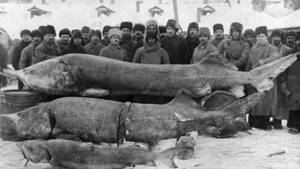
Statistics indicate that the beluga is gradually becoming smaller. If in the 18th century people regularly caught individuals whose mass exceeded a ton and whose length was more than 4 m, then starting from the second half of the 19th century, the maximum weight of caught fish fluctuates around 800 kg, with the same length.
Interesting: Why are river fish more bony than sea fish?
Now the average weight of individuals is in the range from 50 to 90 kg, and the length does not exceed 2 m. Perhaps over the past two centuries, people have been so diligent in catching beluga for black caviar that the fish does not physically have time to grow to large sizes.
Zimovye
Beluga is a red fish that prefers to spend the winter in yatovs (river pits), where it goes out in order to rise and spawn with the onset of spring. Young animals prefer to go to the rivers for the winter or settle at shallow sea depths. Beluga prefers to rest at medium depths, having already spawned eggs and returning to the sea before the first frost. The largest and most mature individuals can only be found at great depths, but due to their physiological characteristics, most of them are no longer capable of reproduction.
Beluga fishing
Beluga fishing
The main place where you can catch beluga is in the sea, kilometers away from the coast. It is difficult for a fisherman to find it. You need a guide who knows everything about fish and can help you find a promising place based on some special signs. It is practically impossible to catch a large beluga in rivers. Juveniles can peck on donks and float gear. However, such fishing is pure poaching.
This fish is a real predator and the best bait for it is live bait. Moreover, despite the large size of the beluga, it prefers small fish. Beluga is most interested in anchovy, herring, roach, anchovies, and gobies. The beluga has poor eyesight, so it can be tempted by something shiny. Young individuals, except fry, can peck at the shell.
To attract beluga to the place where your gear is located, use bait. They use pieces of fish, minced fish, and crushed shells. They fish for beluga from a boat. She must have special stability. The presence of a hook and landing net is required. Beluga is caught more from the bottom, so you need to give preference to bottom gear. The line should be thick. The hooks are reliable and of considerable size. Of the reels, the multiplier is more suitable. The rod must be durable, with high-quality guides, a reel seat, and not be afraid of sea water.
If possible, it is better to use asp and roach for bait. The beluga pecks carefully and lazily. You can hook the fish after a powerful pull occurs. The beluga, pulled to the side, is picked up by a hook and dragged into the boat. Immediately turns her belly up. The latter is necessary so that the fish stops beating its tail.
Natural enemies of the beluga
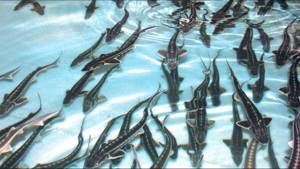
Since the fish is large, none of the sea predators hunt it. In the event of danger, the beluga is able to cope with any enemy, and all the creatures around it understand this.
However, young individuals cannot feel completely safe. Fry and eggs often become food for any meat-eating fish. Moreover, an adult beluga also does not mind feeding on its own kind. Because of this, the overwhelming number of offspring may end up in the bellies of older individuals.
Humans are also actively involved in reducing the population. Poachers are illegally catching beluga sturgeon, waiting for them at river mouths during spawning. This period is not chosen by chance: black fish caviar is very expensive, and during spawning there is a high probability that the caught fish will have several tens of kilograms in its belly.
Interesting: Dangerous predatory fish: moray eel and barracuda. Description, photo and video
People also engage in artificial breeding of beluga sturgeon in order to obtain caviar, but such a business is not always profitable. Fish need to be raised for a long time to be able to produce offspring, but not everyone can provide suitable conditions for a couple of decades.
Interesting Facts
- This is one of the longest living fish. Life expectancy can reach more than 100 years.
- Parents do not care about their offspring in any way. On the contrary, after some time they can eat the slowest offspring.
- During the course, fishermen often watch these sturgeons jump high out of the water. It's an impressive sight considering its size. There is still no clear explanation for this phenomenon.
- These fish, like sharks, anatomically have no bones. Its skeleton consists exclusively of cartilage, only which becomes tough and hard over time.
- Females can contain a very large amount of eggs. The capture of an individual weighing 1200 kg, from which almost 150 kg of caviar was extracted, is documented.
- In the Far East, in the Amur River basin, a closely related species lives - kaluga, which also reaches enormous sizes - up to 5 meters in length and 1000 kg. weight. Attempts by scientists to cross species ended in failure.
Record-breaking belugas
The maximum weight of the beluga is another question that has not been fully clarified by ichthyologists. There are records of specimens weighing up to two tons. However, unfortunately, there is no documentary evidence of these facts . So, the record holders:
- 1827, lower reaches of the Volga River. A press report about the capture of a fish nine meters long and weighing ninety pounds (1,500 kilograms).
- 05/11/1922, Caspian Sea. The catch of a female specimen weighing 1,224 kilograms, including 146.5 kg of caviar.
- The Kazan National Museum of the Republic of Tatarstan has in its exhibition a stuffed 1,000-kilogram beluga with a length of 4,170 millimeters. Presumably the seventy-year-old fish was caught at the beginning of the last century in the lower reaches of the Volga.
- A similar stuffed animal (4,200 mm and 966 kg) is kept in the Astrakhan Museum. The fact of its capture is interesting, since poachers caught this fish and, after removing the eggs, reported their catch to the authorities.
The analysis shows that the overwhelming majority of evidence of the catching of giant beluga specimens occurs at the beginning of the past - the end of the century before last. Significant changes in the ecological situation that characterize the present time have led to the fact that fish of this species rarely reach gigantic sizes. The weight of the largest specimens caught over the past few years does not exceed a quarter of a ton.




